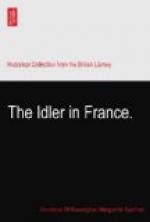This interesting monument appears to have been ornamented with equal care and richness on every side, but its decorations have not enabled any of the numerous antiquaries who have hitherto examined it to throw any light on its origin; and the destruction of its architecture must have caused that of its inscription, if, indeed, it ever bore one.
The mausoleum is even more curious than the arch, as being the only building of a similar character of architecture to be seen.
Placed on a large square pediment, approached by two steps, the edifice rises with unequalled lightness and beauty against the blue sky, forming two stages supported by columns and pilasters, united by a finely sculptured frieze. The first stage retreats from the pediment; and the second, which is of a round form, and terminated by a conical-shaped top, is less in advance than the first, giving a pyramidal effect.
The four fronts of the pediment are nearly covered by bassi-relievi, representing battles of infantry; the figures of which are nearly as large as life, and admirably designed.
On the north front is a combat of cavalry; on the west, an engagement, in the midst of which the body of a man is lying on the ground, one party of soldiers endeavouring to take possession of it, while another band of soldiers are trying to prevent them.
The basso-relievo of the south front represents a field of battle, strewed with the dead and wounded, and mingled with warriors on horseback and on foot. On one side is seen a wild boar between the legs of the soldiers; and on the other, a female figure, quite nude, prostrate on the earth before a rearing horse, which some soldiers are endeavouring to restrain.
In the centre of the basso-relievo is an old man expiring, surrounded by several persons; and at one end a soldier, bearing arms on his shoulder, has been left unfinished by the sculptor; there not being sufficient space for the figure, which is partly designed on the adjoining pilaster.
On the east front is a winged female bearing the attributes of Victory, with several women and warriors, and an allegorical personage said to represent a river, because it holds in one hand a symbol of water. This last figure, also, is partly sculptured on the contiguous pilaster, as is the one previously noted, which proves that these ornaments were not executed at the time of the erection of the edifice.
The pediment has a simple cornice around it, and the angles are finished by voluted pilasters without a base, but with Ionic capitals, which have an extraordinary effect. Above the basso-relievo is a massive garland, supported by three boys, at equal distances; and between them are four heads of old men, as hideously grotesque as the imaginations of the sculptors could render them.
The first stage of the mausoleum which rises from this pedestal is pierced by an arch on each side, in the form of a portico, and their archivaults are ornamented by foliage and scrolls.




